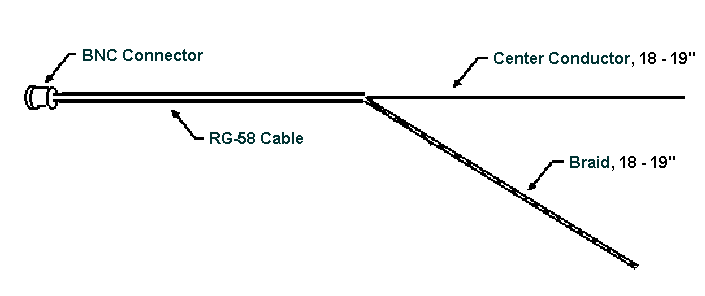How would you like to drastically improve the quality of your air-to-ground communications, especially for those long cross-country flights - for a few dollars?
The standard antenna delivered with the HT (handy talkie) style radio you hang on your harness is the infamous "rubber duck". Although durable, it really isn't a very efficient antenna, preferable only to no antenna at all. A much more efficient antenna is the quarter-wave flexible whip. These are available from ham radio shops and aren't terribly expensive. But at almost 18 inches long, they are cumbersome (careful you don't poke an eye out with that thing!).
This article describes a quarter-wave modified dipole antenna that can be constructed from a few dollars worth of Radio Shack parts, and is as efficient as or better than anything you can buy.
To build this antenna, go to the Radio Shack and purchase a prefabricated 6 foot RG-58 coaxial cable, with BNC connectors on each end. This is a type of cable commonly used to connect computers together in a network.
Cut the cable in half and save one piece for your next antenna. If necessary, trim the remaining piece so it's about three feet long (this dimension isn't critical).
Measure back from the cut end of the cable 18 inches (for business band use) or 19 inches (for 2 meter HAM use), and carefully cut the outer plastic sheath of the coaxial cable with a sharp knife or razor blade. Try not to nick the braided metallic shield underneath the plastic.
Now, skin the plastic coating off of the cut end of the cable. With a little effort you may be able slide off without having to cut it further. Then use a pen or other pointed object through the metallic braid at the point where you cut the outer plastic, separating the braid until you can extract the insulated center wire out through the hole (hint: you can push the braid from the cut end of the cable to bunch it up to give yourself more room to work).
After extracting the center wire, stretch the braid back out. You'll now have something that looks like FIGURE 1.

Starting where you mount your radio on your harness, feed both of the cut ends of the wire through a grommet or other opening to the interior of the harness and around to the back and out a grommet or opening near the main strap. Or if you prefer, feed it around the outside of the harness. Leave the BNC connecter where it can be conveniently connected to the radio (if your radio uses one of the newer SMC connectors, you'll need to pick up an adapter from the ham radio store).
Place the point where the wire splits at the base of your main strap. Run the insulated wire up the strap, inside the velcroed covering if you have one. Use a little duct tape or a tie-wrap to hold the far end of the wire at the top of your harness main strap.
Tie a bit of elastic or thin bungee to the cut end of the braided shield, run it down the exterior of the harness and tie, pin or otherwise secure it to the boot area of the harness. If you saved the outer plastic sheathing that you removed at the beginning of this, you can slide it back over the braid to cover it before securing it to the harness (FIGURE 2).

That's it. Your new harness-mounted antenna will transmit and receive much better than the old rubber duck. And it won't poke you.
Advanced Topics: Antenna Tuning
The lengths shown are suggested lengths for these frequencies and this harness-mounted application. It will give much better performance than a rubber duck, but will not be perfect. Antenna lengths when mounted close to other objects (like your harness and body) are difficult to calculate. The only real way to determine the ideal length for an antenna like this is to use a Standing Wave Ratio (SWR) meter rated for VHF frequencies. Initially cut the antenna slightly long, and then trim for the lowest SWR ratio at the center frequency you're interested in.
